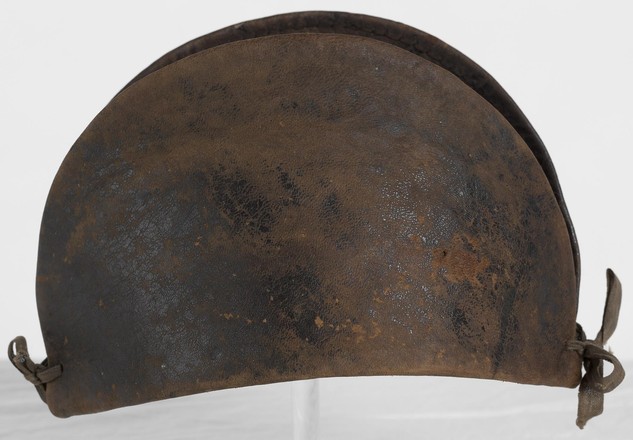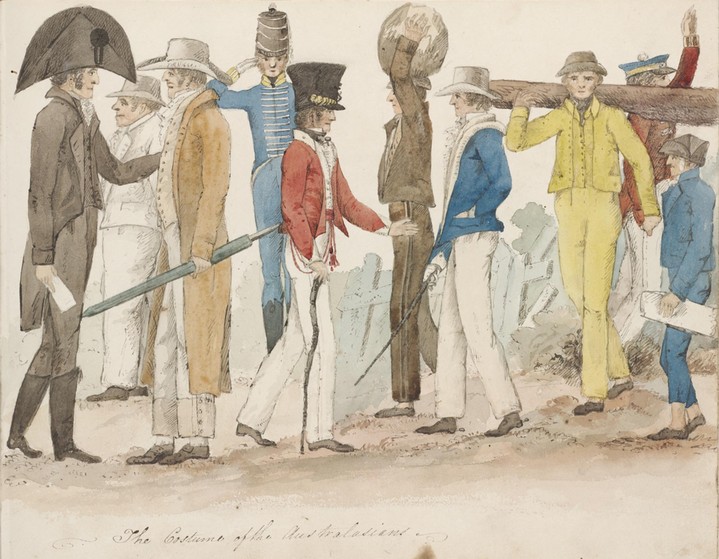Convicts wore distinctive clothes
By Stephen Thompson, Migration Heritage Centre, Powerhouse Museum, 2006
Convicts
wore distinctive clothes to make them instantly recognisable and visible in the
landscape and to signal their rank in the Government System. The first
two-coloured uniforms in Australia were black and white (yellow was added
later) and was introduced by Governor Macquarie into New South Wales in 1814,
and then into Van Diemen’s Land.
Black
and yellow jackets and pants were worn by convicts sentenced to chain gangs
carrying out heavy manual work building roads and culverts as punishment for
recidivist behaviour (reoffending) or as a result of false charges laid by
unjust farmers and squatters. Most farmers and squatters were benevolent, some
cruel. Many farmers and squatters were ex convicts brutalised by the assignment
system themselves.
Male
convicts in Australia typically wore prison ‘slops’, with calico, duff or
canvas trousers, striped cotton shirt and grey wool jacket. In later years,
inmates in female factories wore drab cotton clothing stencilled with a ‘C’,
and convict women might have their heads shaved. Political prisoners, mostly
Irish, wore all-yellow suits, as did all prisoners at Port Arthur.
…
The convict cap has historical significance as a rare garment from the convict
era. The cap was worn with the various convict uniforms, including the black
and yellow type. The cap is evidence of the Colonial Government’s attitude to
and treatment of convicts as indentured labourers in a strict social structure
designed to provide cheap labour to build an expanding British global empire ...
They are quite useless ...
By Brad Manera, Insites magazine, Spring 2007
Caps
like this appear in images of the British Army in the first years of the 19th
century. They appear to have been introduced as an off-duty or fatigue cap at
the same time the army adopted an all leather ‘stove-pipe’ shako as parade and
campaign service headdress. Most of the off-duty British soldiers in W H Pyne’s
scenes of camp life, published in 1803, are wearing them. Illustrations of the
period show that these caps remained in use until the late 1820s. They were a
very popular unofficial item of dress for British soldiers and sailors and even
became a fashion statement for some civilians.
Convicts,
like the army, were supplied by the Board of Ordnance. Men sentenced to
transportation and bound for Botany Bay needed to be clothed. The stockpiles of
surplus military clothing produced for the Napoleonic wars must have been a
temptation for penny-pinching government bean counters after 1815 and so the
convicts found themselves wearing military headdress and other ex-army
cast-offs.
…
The watercolour Costumes of the Australasians … [records] for posterity just
how common these leather caps had become. But were they popular with the
convicts?
The
weight of opinion would suggest not, as convicts were said to prefer woollen
caps in winter and straw hats in summer. When Commissioner John Thomas Bigge
asked Major George Druitt of the 48th Regiment of Foot, the first
superintendent of convicts at Hyde Park Barracks, in 1819 about whether the
leather caps issued to convicts were serviceable Druitt replied ‘They are quite
useless, and afford no protection to the head from the sun’. Druitt went on to
claim that the men preferred broad brimmed straw hats and resorted to stealing
them when they could not be acquired by other means.
Despite
Druitt’s criticism the leather caps remained part of the convict uniform at
least into the 1850s. Quaker missionary Frederick Mackie sketched convicts
wearing them in 1853 at Port Arthur in Van Diemen’s Land. These sketches
occasionally show them worn in an unorthodox manner, with the fold from side to
side, rather than from front to back as was usual, and with one brim folded
down to create an eyeshade.
Loved
or hated, serviceable or useless, the eccentrically shaped leather cap is an
evocative reminder of our convict past.
‘The costume of the Australasians’
This
drawing is a primary source for the history of clothing in Australia.
Distinctive in its social inclusiveness and its tone of amiable satire, it
includes rare images of convicts, and records the prisoners apparent easy
co-existence with free settlers and with their military gaolers.
You can see a total of ten figures including the Governor’s aide-de-camp Lt
John Watts; an officer; soldier; a bandsman of the 73rd Regiment (McLeod’s
Highlanders); wealthy colonial figures; and convicts on government service who
appear to be wearing leather convict caps.



 Back to list
Back to list